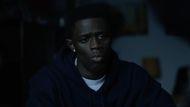A Thousand and One paints a portrait of Harlem’s shifting streets, where gentrification looms and one mother, ex-con Inez, pulls off an audacious heist: Reclaiming a child she never legally had. A.V. Rockwell’s tender and harrowing debut survives on the tension between love and law, a tension that comes to a head in its devastating finale.
Through moments and raw interactions, we learn why Inez commits the crime, and the twist that seals it all off changes the whole movie's plot in its last minutes. Here's what the plot of A Thousand and One means and what you need to know about Inez.
Disclaimer: This article contains the writer's opinion. Readers’ discretion is advised.
What is A Thousand and One about?

In A Thousand and One, director A.V. Rockwell takes us deep into the heart of a fractured city and a fractured family, where love is messy, survival is a full-time job, and the system is always watching but never helping. The story begins in 1994, with Inez de la Paz, a hairdresser, ex-convict, and a woman who has seen more heartbreak than most, walking free from Rikers Island. She heads straight back to Brooklyn, to the neighborhood where she once found shelter, and stumbles upon her six-year-old son, Terry, playing on the street with other kids from his foster home.
After Terry lands in the hospital trying to escape that home, Inez sneaks in for a visit. It is tense because he remembers being abandoned on a street corner at age two. When he is set to be transferred to another foster placement, Inez asks him, simply, if he wants to come with her. He says yes. And just like that, she takes him.
What follows is not a fairy tale. They bounce from place to place, squatting and scraping until Inez lands a job at a nursing home and saves enough to get their own apartment in Harlem. She forges documents for Terry, a birth certificate, a social security number, so he can start schooling and live like a child with roots.

Somewhere along the way, she reconnects with Lucky, a fellow thief from her past. Despite his hesitation, he agrees to help raise Terry, and the two marry, hopeful that Mayor Rudy Giuliani’s shiny promises of a “New York reborn” might give their son a better life than they ever had.
But time and the city are not kind. Stop-and-frisk became law. Harlem begins to gentrify, brick by brick. By 2001, the cracks in Inez and Lucky’s marriage are undeniable, with long absences, affairs, and quiet disappointments piled up. Terry, now 13, is a gifted student facing constant police harassment, but still manages to thrive. His teachers recommend him to a prestigious STEM school. Terry wants to compose music, not chase science, but agrees to take the exam to please Inez and Lucky.
Inez can’t fix her marriage, but she is clinging to the dream that Terry might just outrun the life she fought so hard to rewrite. When Michael Bloomberg steps in as mayor and chain stores replace Harlem’s soul, Inez watches the city shift and wonders if everything she has done will be enough.
The big revelation

As Terry nears college and the weight of adulthood creeps in, cracks begin to show. Lucky dies of cancer, and on his deathbed, he opens up on his infidelity and self-loathing, and how much he hurt Inez. Although he tried to be a present father, he was an absent partner and often unavailable. He accepts his flaws and apologizes.
After his death, things take a worse turn. Their new landlord wants them out, money is tight, and Terry applies for a job. When his guidance counselor asks for his documents, he hands over the forged ones without telling Inez. The system catches up, the papers bounce back, and social services are called. Terry then calls Inez up and tells her what happened, giving her a chance to get away before she is caught. As he does, she finally confesses that she isn’t Terry’s biological mother and she never was.
Later, when Inez returns to quietly pack up and vanish once more, Terry finds her. In a hushed, heavy moment, Inez tells him the truth that she is not the woman who abandoned him that day. She is the one who found him, chose him, and loved him like he was her own. Terry, devastated but composed, listens. And though his world has shifted forever, he tells her he still sees her as his mother.
They part, again, and this time, by choice. So Terry can rebuild a life that is finally his, and Inez can disappear before the system brands her a kidnapper. She leaves him with a promise: This isn’t goodbye.
What does the ending of A Thousand And One signify?

What makes A Thousand And One hit so hard isn’t just its political bite — it is how that bite is personal. The film doesn’t waste time showing you the faces behind broken systems. Instead, it zooms in on the people crushed beneath them: Inez and Terry. The film even combines real-life recordings of Giuliani and Bloomberg and their real-life speeches with the backdrop of the city, highlighting the political state of the country.
Talking about A Thousand and One's ending in March 2023, writer-director A.V. Rockwell told Filmmaker Magazine that:
"I wanted to tell a story about a family versus the city. I was trying to understand what happened to New York City as I knew it, and what was happening to communities of colors that felt targeted—trying to tell that story but also parallel it against what my experiences have been or experiences other Black women have [had] coming of age in this environment."
Through their everyday lives, the story explores how a chosen family can matter more than blood, and how radical empathy is sometimes all you have got to give. And maybe the film’s final question isn’t Was it legal? Or was it moral? Maybe it’s: Why does someone like Inez have to risk everything just to give a kid a shot at softness?
Inez doesn’t rescue Terry because she is some saint, but because survival for people like her comes with asterisks and fine print. So much that love becomes an act of rebellion.
A Thousand And One is available to stream on Amazon Prime Video.
Love movies? Try our Box Office Game and Movie Grid Game to test your film knowledge and have some fun!
